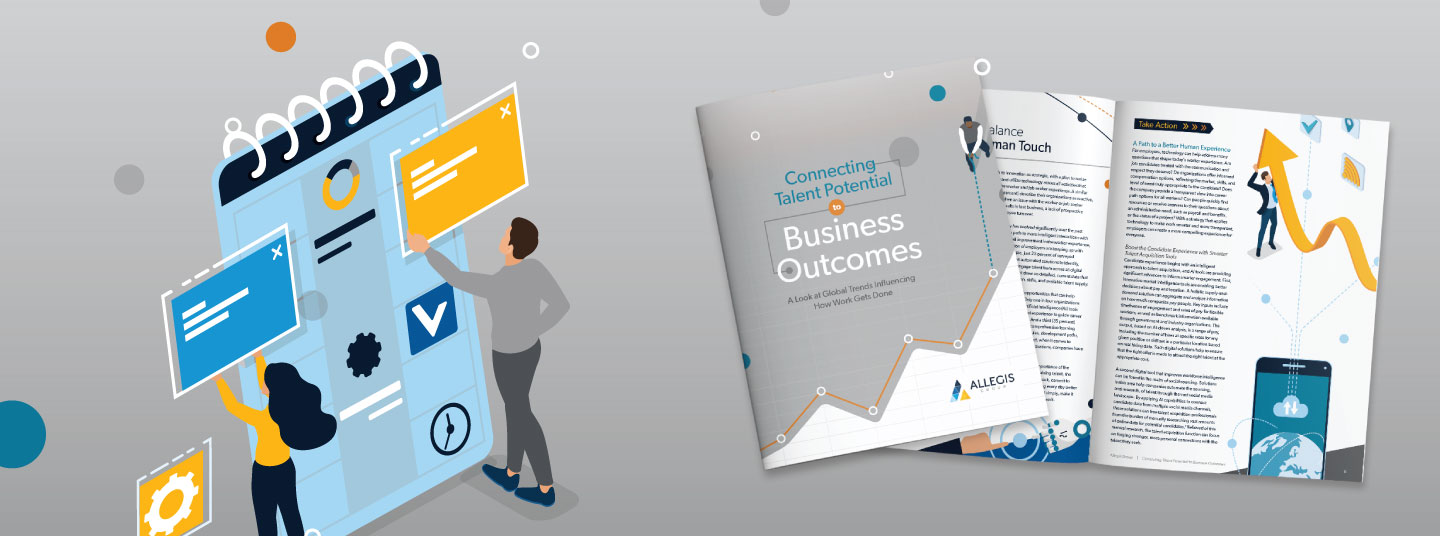New Report: 4 Global Trends Influencing How Work Gets Done
Organizations have enormous potential to create value and improve careers, but translating potential into real results depends on how they adapt to emerging trends.
For answers on how to address such workforce challenges head-on, download a new report from our parent company Allegis Group. “Connecting Talent Potential to Business Outcomes” tackles four trends shaping today’s most pressing talent needs and offers strategies to drive positive business outcomes. Packed with insight to redesign how work gets done, global survey findings from nearly 4,000 workers and HR and business decision-makers, plus expert commentary on talent acquisition and flexible workforce engagement, the free report is available for immediate download today.
Stay Ahead of Today's Workforce Challenges
As Allegis Group’s research finds, the challenge for organizations in adapting to the evolving talent landscape begins with how they connect people and resources. Among global HR and business decision-makers surveyed:
- 79 percent say it is more difficult to attract and retain talent with critical skills than it was three years ago.
- 49 percent say it is harder to determine what talent and technology resources are needed to accomplish key goals, projects, and initiatives than it was three years ago.
- And, most believe the inability to secure talent effectively could impact core business capabilities, resulting in compromises in operations and service delivery (cited by 84 percent), limitations on business growth and profitability (84 percent), and obstacles to innovation (77 percent).
For their part, workers around the world agree there is room to improve and want more from companies as a result:
- 87 percent say organizations need to do a better job of providing resources and technologies to attract the best job seekers and retain employees.

Strategies to Keep Pace with Innovation and Address Workforce Challenges
Companies will continue to experience the pressure to explore better approaches to secure talent and new ways to achieve outcomes. But as the report reveals, forward-thinking companies can keep pace with innovation and address today’s most pressing workforce challenges by helping workers evolve their skills. Businesses can also get creative about how they engage talent and get work done.
The report outlines four key priorities for connecting workforce strategies to business outcomes. The resulting approach is one that delivers more channels to multiple forms of talent, more options for improvement, and the agility to succeed in a changing and unpredictable global talent marketplace.
- Apply technology to make every day better for the people who drive business success: Companies see the human factor as a major influence on their ability to attract and retain workers, so they are seeking to apply technology to improve the personal aspects of the job. In fact, 58 percent of global HR and business decision-makers surveyed cite the push to humanize the talent experience as a priority to improve talent attraction, productivity, and retention.
- Identify the right outsourced services while better managing engagements and budget at the enterprise level: With a rising dependence on specialized skills and functions, the use of outsourced services as a way to leverage talent to get work done is increasing steadily. Among global HR and business decision-makers, 45 percent consider outsourcing more often today compared to three years ago as an alternative to direct hiring.
- Take a total talent approach to see all workers through a single lens: Today’s professionals increasingly embrace engagements as contractors, freelancers, or consultants. Yet, only 28 percent of global HR and business decision-makers can access contractors, employees, potential candidates, freelancers, workforce suppliers, and services partners on one system. Savvy companies embrace total talent strategies to bridge the gaps between legacy processes and technologies specific to each worker type. By doing so, they gain visibility into the entire workforce supply through a single view.
- Get proactive about compliance: Among global HR and business decision-makers, 59 percent say changing regulations over the past three years have made it more difficult to secure flexible talent. As a result, 34 percent have added staff on legal, compliance, or risk teams, and 27 percent experience slower decision-making due to legal review. Smart businesses are applying digital tools for clearer worker classification, building a culture of compliance awareness, and leveraging internal and external partners for support, expertise, and technology.
Redesign How Work Gets Done
“For organizations committed to evolving their approaches to engaging workers and resources to achieve outcomes, there is a tremendous opportunity to realize a competitive advantage,” says Allegis Group President Andy Hilger. “Allegis Group companies have always been dedicated to helping clients lead in their markets, so we’re pleased to be able to share what we’ve learned about the leading trends in today’s business environment of rapid change and innovation.”
“Connecting Talent Potential to Business Outcomes” is a great starting point for moving your workforce strategy forward. We hope the report helps you achieve positive business outcomes more quickly and efficiently than ever before. If you’d like to discuss these topics further or explore more ways to inform your workforce strategy, please get in touch with us.
-min.png)




